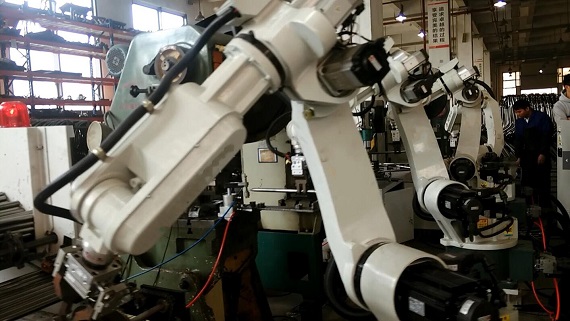The emergence of
automation equipment has changed the traditional manual mode of operation, so that the production efficiency of enterprises rose substantially, production costs significantly reduced.
While many companies and groups that advocate automation see reports that automation is causing factory workers to lose their jobs as rumor-mongering.
But in the short run, they have to admit that automation is indeed a factor in job losses.
1. Industry 4.0 giant mode.
The main custom research and development of large production lines, and unmanned factories.
However, China started relatively late in this field and has a weak industrial automation foundation. We are always in the stage of catching up.
These giants are basically monopolized by multinational groups, such as ABB, Siemens, Kuka, Epson and other manipulator manufacturers.
2. Self-sufficiency model.
Large manufacturing enterprises such as Foxconn have begun to set foot in the development and production of robots.
This branch, have capital, oneself also have the huge demand of non-standard automation equipment.
I once worked at a large lithium-ion battery company, where the model was to build its own non-standard automation team and develop most of the equipment in-house.
Apart from large assembly lines and sophisticated equipment, the company is largely self-sufficient in automation equipment.
At present, some of the larger companies have their own automation equipment department.
3. Diversified production mode.
Due to the non-standard industry, many companies will have a bottleneck to break through at the stage of development.
Many bosses of non-standard automation are trying to diversify into traditional manufacturing.
Because these enterprises can produce their own equipment, so the equipment input cost is low, and the production efficiency is high.
The impact on ordinary businesses is huge.
4. Combination of strong and strong.
In the future, if a manufacturing company does not have an automation equipment department, it will not be able to survive.
In the face of decreasing profit space and high labor cost, only by fully implementing automatic unmanned production and improving technological level can enterprises remain invincible.
Some manufacturers around the boss, began to try to buy some small non-standard automation companies, to build their own non-standard automation team.
One is to reduce the input of equipment, and the other is to improve the level of automation in production.
Or non-standard automation companies to acquire some manufacturing enterprises, through this fast way into the traditional manufacturing industry.
5. Independent mode.
Constant practice of internal skills, improve the level of technological innovation.
Do people have no I have, I have excellent.
It is important to establish standardized design and production models.
All of the non-standard industries have been slow to develop because most of the equipment needs to be customized.
The company needs to invest a lot of experience in research and development.
And assembly production process, for the workers of the technical level is quite high.
Therefore, the way out for the future development of non-standard automation companies is to establish a large database and adopt standardized and modular design methods.
Only in this way can we get twice the result with half the effort.
"The solution is to train the people we already have.
Because robots and automation can help reduce costs, we will definitely embrace it in the future.
But if you think about it another way, if you reduce the cost, then you have a bigger innovation budget.
With a bigger budget, we can develop more new products.
With more new products, I have to hire more people to develop and market them."

To be honest, this trend has happened before.
Early in the industrial revolution, technology had an impact on the workforce.
Not only has automation reduced the number of jobs, but the types of jobs have also changed.
At the beginning of the 20th century, 41% of jobs in M were related to agriculture.
A century later, that figure had fallen to 1.9%.
But as the saying goes, when God closes a door, he opens a window, and automation won't put everyone out of work.
A representative of one technology company said in an interview that most of the jobs lost due to automation were concentrated in the same position.
We can see this in a study published by Boston University in late 2015.
Jamese. Bessen, the report's author, points out that "automation does not replace important jobs in general.
In addition, there are many reasons to cut a job.
Sometimes, it's because there's less demand for the position, like an apartment manager.
Sometimes, it's because the technology used in the position is out of date, such as telegraph operator.
It's rare to see a job eliminated because of automation, such as an elevator operator."
Even if job losses continue to rise as a result of automation in the future, automation proponents say, they will be concentrated in jobs that no one wants.
DavidAutor, an economist at the Massachusetts institute of technology, agrees that automation will only replace jobs that people do not want to do.
While his comments were less radical than those of his peers, he noted that people's increasing reliance on professional machines did contribute to the widening gap between rich and poor.
It's a vicious circle, with unemployment rising, making it nearly impossible for workers to get the education they need to escape poverty.
He added: "There is no denying that automation has had a huge impact in terms of the structure of Labour and the return on the skills acquired.
But I don't think it's responsible for the current rise in unemployment.
Of course, automation has reduced job opportunities for the less educated, but it has also had a lot of social and even political consequences."
Although automation may replace much human Labour in the short term, the gap could eventually be filled, as in the case of agriculture.
It is also important to note that with the spread of automation, companies have significantly increased productivity and business profits, so that they have more money to scale up and hire more people.



